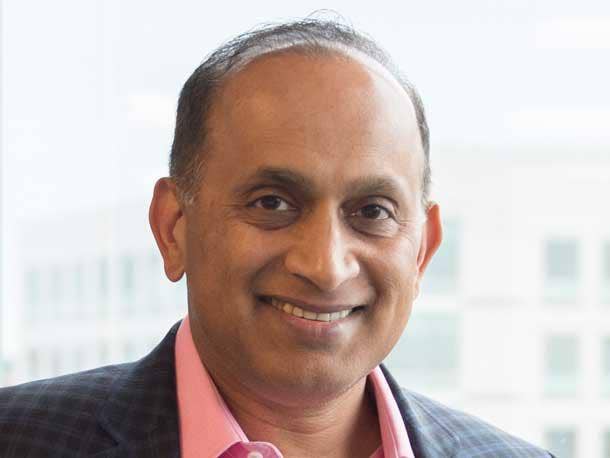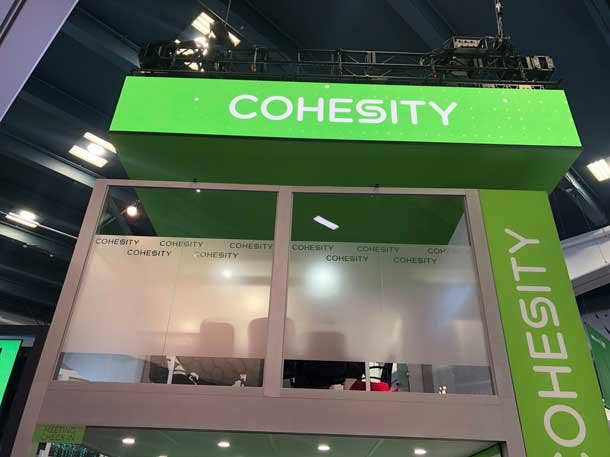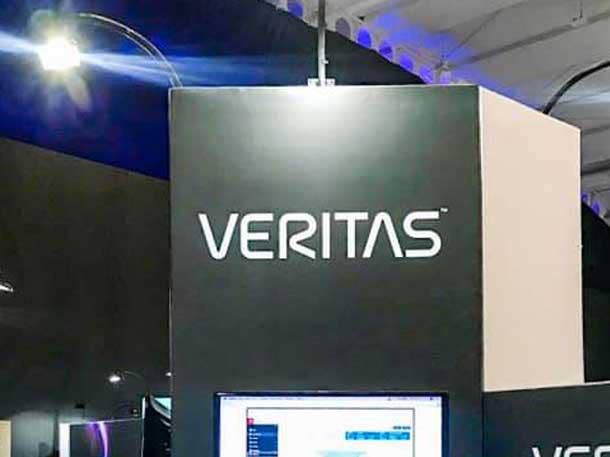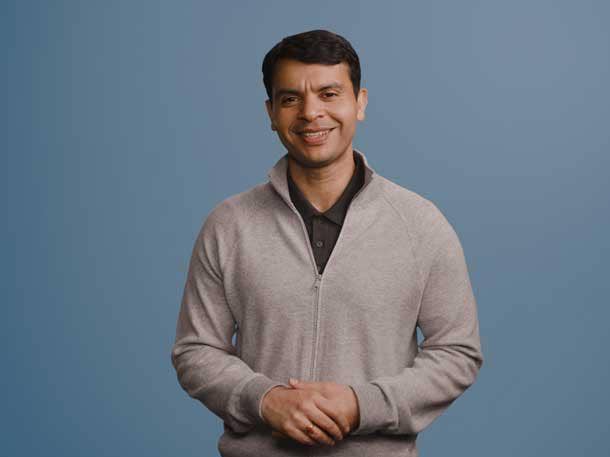New Cohesity CEO Sanjay Poonen: ‘Standing On The Shoulders Of Giants’
‘I have always sort of dreamed of having a technologist who I could partner with. I know certain products and product management and technology. But I also have a lot of experience and skills in go-to-market. I don‘t think this combination exists with anybody else in the data management space, where you’ve got an incredible technologist and a powerful go-to-market combination,’ says Cohesity CEO Sanjay Poonen in reference to Cohesity co-founder Mohit Aron.

Cohesity’s Next Growth Stage: Mohit Aron Makes Room For Sanjay Poonen
When data protection technology developer Cohesity this week unveiled former VMware Chief Operating Officer Sanjay Poonen as its new CEO, it wasn’t a case of its former CEO retiring or leaving the company. Instead, Mohit Aron stepped aside from the president and CEO roles he has played since he founded the company in 2013 to focus on innovation, and brought Poonen in to lead the company on its next phase of growth.
The fact that Aron still plays a major role in Cohesity was one of the most important of many factors behind the decision by Poonen to join the company. Poonen, in an exclusive meeting with CRN, praised Aron, who previously was an engineer at Google before founding Nutanix and then Cohesity, as a technical genius.
“[Aron] built the file system at Google,” he said. “He was the key architect and CTO at Nutanix. All sort of checks I did on him, and as I got to know him, I saw this guy‘s smart, he’s a person of high integrity, and he’s really passionate about customers.”
[RELATED STORY: AVIATRIX CEO ON POTENTIAL POST-BROADCOM VMWARE LAYOFFS AND WHY ON-PREM MARKET IS ‘THE TITANIC GOING DOWN’]
The prospect of working with Aron is important to Poonen.
“We need to be like Stephen Curry and Klay Thompson, the Splash Brothers,” he said. “And it doesn‘t matter who gets the ball, they score and win because of strength in numbers. So in some sense, I have always sort of dreamed of having a technologist who I could partner with. I know certain products and product management and technology. But I also have a lot of experience and skills in go-to-market. I don’t think this combination exists with anybody else in the data management space.”
While Cohesity has already quietly filed for confidential S-1 in preparation for a possible IPO in the future, Poonen’s more immediate concern as he takes over Cohesity is meeting with customers and employees, and building on the company’s huge partner ecosystem as a way to drive growth.
“I feel the two of us can go cement incredible partnerships, convince any customer. … I think the odds of success are very high,” he said. “I just have to keep making sure that Mohit’s motivated, and he is, as we embark on the journey.”
For a more detailed look at what’s in store for Cohesity under its new CEO Sanjay Poonen, click through the slideshow.

Congratulations on taking over as CEO of Cohesity. Why Cohesity?
As I looked at the market and spent the last 12 months looking at a lot of companies, investing in companies, I’m on two boards, I think there‘s a confluence of three factors at play here. One is cloud, the second is security, third is data. I’ve been tracking this industry. Twenty years ago, I worked at Veritas. All the five or six companies that are the so-called leaders in the space, for the last seven or eight years, certainly in my time at VMware, what struck me about Cohesity was a couple of things. One is, the founder is a tech genius. I mean, he built the file system at Google. He was the key architect and CTO at Nutanix. All sort of checks I did on him, and as I got to know him, I saw this guy‘s smart, he’s a person of high integrity, and he’s really passionate about customers. …
Then I looked at the next thing, which was how customers started to perceive this. I knew many of their customers already, but I had a sense that the biggest customers in the world were picking them. So I called a few of them discretely, myself, and did my due diligence. And one global Fortune 100 company told me they had not seen tech like this since VMware 20 years ago, Amazon 10 years ago. So I was starting to sense the validation from many of these large customers Cohesity is winning. And I think many of the large customers are making choices to move off legacy platforms to more modern ones, and I think Cohesity is at the cusp of really winning a lot of those customers to their platform.
And I think the final piece was the partner ecosystem. I really felt like this was an opportunity for the cloud and the on-premises server and storage vendors. I was very impressed by the number of people who invested in this company as a strategic corporate investor. AWS had invested in the company, Cisco, HPE. And I know those strategic partners. I think we can really dial up all of those partners, especially Amazon. Every hyperscaler, every server and storage vendor, every SaaS and on-premises apps company, and then the VARs, these are people I‘ve dealt with for the last 20 years. I know them all very well. So I felt we could use the ecosystem as a force multiplier. And I’ve always said, when you work with ecosystems, it‘s sort of like that Isaac Newton statement: You see clearly because you are ‘standing on the shoulders of giants.’ So my intent is to really cement much stronger relationships with all those partners.
Have you worked at all with Cohesity prior to joining the company as CEO?
Yes, as a partner of VMware. All these folks in this space are probably exhibitors and partners at VMworld. So I got to see all of them. I wouldn‘t say worked exclusively with them. But I would say from my vantage point there, I had the most respect for their tech. Their awareness probably wasn’t as high as some other players. They‘re a smaller company. But I had a lot of respect for their tech. And my own sense was that they had the best tech of anybody when I was at VMware. So I’ve worked with them, not exclusively. We partnered with everybody. … When I talk to global customers, I sensed some of our largest customers were picking them.

You worked at Veritas 16 years ago. From that time until now, the storage industry has changed a lot. What are some of the big differences that you see in the storage industry compared to back then, and how does that fit with what Cohesity is doing?
I‘m not the expert in the storage industry. I would say I have some ideas about it. [But] I’ll give you a few of my instincts. Clearly, there is a significant move of storage to the cloud, and cloud storage is getting better, faster, cheaper in a variety of forms. I‘ve seen the growth of [Amazon] S3 and slower forms of storage like [Amazon] Glacier and their equivalents, and various different blob and block storage options in the public clouds.
The second trend is certainly the bigger push towards hyperconverged infrastructure, which I certainly saw and advocated for at VMware with vSAN and VxRail in partnership with Dell. And now I get to also partner with Nutanix, because they’re no longer a competitor of mine at Cohesity.
And third, I would say, I was beginning to track a number of open source projects like MinIO and others who are really doing some creative things. The community was starting to really develop options for ways by which storage can leverage on-prem or in the cloud in cheaper, faster, better ways. So all of those then led to use cases that could even scale better and faster for databases, data warehousing, analytics, and the stacks above that, whether it was Snowflake or some traditional databases or next-generation open source databases that are going to be able to take advantage of those storage attributes.
I think the security industry hasn‘t really done as much with data security. They’re focused on network security and endpoint security. So data security, and the increased focus on ransomware was an opportunity for digital security, for storage companies including Cohesity to start developing some security chops, too.
So those are some of the things I saw as major trends. I‘m not the expert in storage, but those are three or four things that certainly influenced my thinking as I come into this company.

Cohesity co-founder Mohit Aron
So why did Mohit decide that it’s important for him now to step aside as president and CEO to focus more on the product side? What’s changing in terms of what he‘s doing?
That was to me also an important question. Certainly, you should ask him that question. But I would say that he felt like he was really good at going really deep on technology, and his passion wasn‘t really having to run the whole company, the sales and marketing ecosystem. And he went to the board. It was his decision. I mean, I was very concerned that Cohesity was losing him. In fact, I spent the last few months very discreetly and going for walks with him to get a sense that he is not lost any steam, because I wasn’t going to go into this company if he was checking out. I wanted to make sure that he was fully engaged.
And he wants to go deep in product and the innovations he has built so far, and focus on taking that to the next level, which is fantastic for me. We need to be like Stephen Curry and Klay Thompson, the Splash Brothers. And it doesn‘t matter who gets the ball, they score and win because of strength in numbers. So in some sense, I have always sort of dreamed of having a technologist who I could partner with. I know certain products and product management and technology. But I also have a lot of experience and skills in go-to-market. I don’t think this combination exists with anybody else in the data management space, where you‘ve got an incredible technologist and a powerful go-to-market combination.
So that‘s the opportunity I saw. I looked at the landscape, I looked at competitors, and I feel like the two of us can beat any of them. So now game on. I feel the two of us can go cement incredible partnerships, convince any customer. And I don’t think we‘re going to compete with the public cloud guys because they could all be big partners of ours. I don’t want to compete with the big application players like Salesforce or SAP because they can all be partners of ours. So I think the odds of success are very high. I just have to keep making sure that Mohit’s motivated, and he is, as we embark on the journey. It‘s not a raw startup starting from $0 million revenue. They’ve got 3,000 customers. They’re well established. They filed a confidential S-1 last year. So it‘s not completely mature, but it’s a reasonably mature company which now just needs to be taken to the next level. I felt there wasn‘t as much awareness of who Cohesity is. I mean, many companies haven’t heard of their brand. But that‘s something that starts to change starting today.

I was going to ask you about that confidential S-1. Does the fact that you‘re joining Cohesity now accelerate the company’s move to enter the public market?
We‘ll be watching that. I think everyone’s in the same boat of just watching where the market is. And we don‘t have anything to say about that other than what was released in the press release last year when we filed it. The company is in good shape, and it’s well run. This is not a company that‘s broken or looking for a new CEO. This is a company that’s strong and is adding strength. So watch it. Everyone‘s who was in the sort of state of waiting for the market is probably in the same state of waiting to see where and how the market evolves. And I feel very good. You want to be in that position, if you’re waiting and assessing, to be in a position of strength where customers are winning.
The other thing that I was impressive with, we can’t talk about exact revenue numbers right now, but if you look at the IDC numbers from last year, which tracks the revenue of companies in this space, we are the fastest growing of the large vendors. So this is a growth story. Part of the challenge of the storage industry is many of the companies stop growing, they’ve slowed the growth, it‘s viewed as a very sluggish space, it’s not growing. We have to keep this a growth story like it has been for that IDC data. And if we do that, an IPO it‘s a milestone, a point in time. It’s not the be-all, end-all destination of the company.

As you look to the rest of 2022 and into 2023, what are some areas you are looking at in terms of where you can make a big impact, or some changes to some of the programs to really build that growth and keep the company moving forward?
I wouldn‘t call these first two changes, but they’re just amplifying. It starts with employees. We had 30,000 people at VMware, and we had 80,000 people at SAP. Over many years, I was able to meet many of them. This company has 2,100-plus employees. Over the course of the next year, I can probably meet every one of them. Today, we did a call with the vice presidents. I‘m looking forward to really getting this to be the best company to work for. This is both in terms of retaining current people, but also recruiting new people. My inbox is just blowing up from people who are like, ‘Man, I didn’t know you joined the company.’ So we‘re going to get a lot of interest. But I want to first thank their existing employees. It starts with an engaged employee for us.
Second, I will be meeting the top 100 customers, the next 500 customers. We’ll have customer events, and listening to them to understand what we were doing well and what we can improve. And we‘ll do many of those actually jointly with Mohit.
And the third is I really think is ecosystem expansion. I would say the company‘s done well. But I think I want to take it to a whole new level. The cloud partners, the service and storage vendors, the apps vendors, the SIs (system integrators), the VARs, are all ones who need to become a force multiplier. And I think there’s a lot of opportunity for many more of them to get engaged with us than have been. And many of them are people I know at the CEO level at those companies and those partners of ours.
And then finally, marketing awareness. I would just say, listen, a lot of people today don‘t know about Cohesity. One day, I hope we’re a brand as big as VMware and Amazon, but we‘re a smaller company. We need to be the best known brand in our category, and then certainly showcase why the marquee global 2000 or Fortune 1000 customers are picking us over one of the other competitors in the space, whether it’s the legacy players or the more modern players in the space.